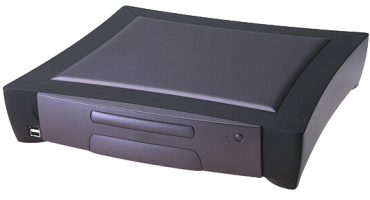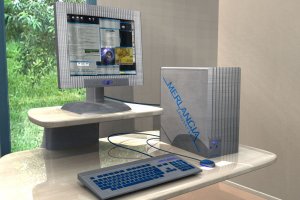|

Merlancia Industries were an authorised US Amiga dealer
located in Phoenix, Arizona (USA). They announced the development
of several hardware devices marketed the business and consumer industries
during 2000-2001. However, the company did not have the funding
or technical expertise to deliver these products. These products
exist on paper only.
MMC Apocolyps DT
MMC Apocolyps Leopard LT
Merlancia MCC/Apocolyps ST
MMC Tsunami
Hurricane UltraLite palmtop
MMC Radian
MMC Apocolyps (DT)
The Apocolyps was a mid-range PowerPC system to be sold in configurations
for the desktop. It was to be sold in three processor configurations,
including the 8240/200, 7410/500, and 7450/733 CPU and would be
installed with a choice of operating systems (Amiga OS, Amiga DE,
BeOS, Linux, QNX were cited).
The release schedule for the Apocolyps may be considered optimistic.
The product was announced in summer 2000 and had a planned alpha
release for November 2000, followed by a pilot release in January
2002. The Apocolyps desktop would be made available sometime during
February/March 2002 (later changed to Q1/Q2 2002), followed by the
release of the laptop in summer-autumn 2002 (Q2/Q3-2002). The company
announced an estimated retail price of $1999.95 and $2499.95 USD
for the desktop systems.
| Processor: |
Motorola PowerPC 7XXX & 8XXX Series:
- 8240/200 Single Processor
- 7410/500 Single Processor
- 7450/733 Single Processor
|
| Memory Configuration: |
133 MHz SDRAM
2 DIMM sockets
128MB - 1GB |
| Graphics: |
Matrox G400 Millennium Video card (fitted to AGP
socket) |
| Storage: |
20/30GB Hard Disk (50GB option on desktop)
Slot loading DVD Drive |
| Expansion & Ports: |
133 MHz Processor fitted with the system's Processor
card
2x PCI slots
1x AGP slot
MIDI, In Out & Through
IEEE 1394 (Firewire) 100/200/400 Mb/s transfer rates
Ethernet 100bT RJ-45 connector
4 Industry Standard USB Connectors
IDE/ATA100, 4 (up to 4 fixed or removable storage devices)
DB15 Game Pad port |
| Input: |
USB Connector
Mouse and Keyboard included
Touch sensitive Keyboard and Trackball will be available separately |
| Audio: |
Sound Chipset |
MMC Apocolyps Leopard (LT)
The Apocolyps Leopard was a high-end laptop intended for the commercial
and high-end consumer market. The laptop was announced in 2000 as
the Apocolyps LT, but was later changed to the Apocolyps Leopard
in mid-2001. Two versions were announced, to be fitted with the
PowerPC 7410/500 or 7450/733 processors.
Merlancia indicated the laptop would enter alpha release in November
2000, followed by pilot release in January 2002 and final release
during the 2nd/3rd quarter of 2002. The company announced an estimated
retail price of $3499.95 - $4299.95 US Dollars.
| Processor: |
Motorola PowerPC 7XXX Series:
- 7410/500 Single Processor
- 7450/733 Single Processor
|
| Memory: |
133 MHz SDRAM
1 SODIMM socket
128MB RAM (maximum 1GB RAM) |
| Graphics: |
Matrox G400 Millennium Video card (fitted to AGP
socket) |
| Sound: |
Sound Chipset
Stereo sound out |
| Storage |
20GB hard disk
Slot loading DVD-ROM |
| Expansion & Ports: |
133 MHz Processor fitted with the system's Processor
card
1 PCI dock connector
MIDI port-link
IEEE 1394 (Firewire) 100/200/400 Mb/s transfer rates
Ethernet 100bT RJ-45 connector
1 Industry Standard USB Connector
IDE/ATA100
Video Out |
| Input: |
USB Connector
Mouse and Keyboard
Touch sensitive Keyboard (optional) |
Merlancia MCC/Apocolyps ST (set-top)

The Merlancia MCC was positioned as a low-end consumer Internet
appliance/kiosk device, similar to Gateway's unreleased
set-top box.
The Coldfire processor was initially identified as the processor
for the MCC. However, Merlancia appear to have changed it to a PowerPC
8xxx processor at a later date. The motherboard was to be fitted
with an on-board TiVA AGP video and sound card, in addition to 2
USB sockets, DB15 game ports, IDE/ATA100 interface, and an Ethernet
100bT RJ45 connector.The release schedule indicated the board was
enter alpha status in December 2001; to be followed by a pilot release
in January/February 2002, and final release in March / April 2002.
The Merlancia web site indicates an expected retail price of $1999.95
- $2999.95 US dollars.
| Processor: |
Motorola PowerPC 8XXX Series:
- 8240/200 Single processor
- 8240/250 Single processor
|
| Case design |
'high quality' stainless steel |
| Memory |
133 MHz SDRAM
1 SODIMM socket
128MB RAM (max. 512MB) |
| Storage: |
10GB hard disk |
| Expansion: |
Ethernet 100bT RJ45 connector
2 USB Sockets
IDE/ATA100
DB15 Game port |
| Graphics: |
TiVA Video Chipset |
| Sound: |
Sound Chipset
Stereo sound, Composite (NTSC or PAL) video, and RGB video out. |
| Input |
Infrared touch sensitive keyboard with built in trackpad |
MMC Tsunami

The MMC Tsunami System was planned to be a desktop system marketed
towards the high-end multimedia industry. It was to be sold to the
Apple Mac market, but would offer features that would attract former
and current Amiga users. The machine was to be designed by Merlancia
Industries, in cooperation with bPlan and would be sold using three
variations of the PowerPC G4 74XX processor.
- PowerPC G4 7410/500 single processor
- PowerPC G4 7450/733 Single Processor
- PowerPC G4 7450/733 Dual Processor
The MMC Tsunami was announced in summer 2000 and had a planned
alpha release for February/March 2001. The alpha system would be
sold to developers only for an estimated $1699.95 - $1999.95 US
dollars. A pilot release was planned for July/August 2001 and a
finalised version was planned for November/December 2001. The single
processor systems would sell for an estimated $1999.95 - $2499.95
US dollars, dual processor systems would retail for $3499.95.
Each machine would offer the following components.
| Memory slots |
2x DIMM sockets |
| Installed Memory |
128MB RAM 133MHz SDRAM
|
| Maximum Memory |
1GB |
| Graphics |
Matrox Millennium G400 |
| Storage |
30GB Hard Disc (UltraATA, SCSI-III Optional)
Auto-Inject Floppy Disk Drive
Slot loading DVD-ROM |
| Expansion |
133 MHz Processor fitted with system processor card
4x IDE/ATA100
3/5 PCI slots (expandable to 8 with an optional buscard)
1x AGP slot
MIDI, In Out & Through
Firewire (IEEE 1394) 100/200/400 Mb/s transfer rates
Ethernet 100bT RJ-45 connector
4x Industry Standard USB Connectors
|
| Legacy |
2x Standard PS/2 Connectors (Keyboard
and Mouse)
Standard Serial and Parallel Ports
DB15 Game Pad port |
The system specifications indicate a 'CLeo' custom chip would be
implemented in later revisions of the disk controller to allow the
use of native Amiga format disks.
Hurricane UltraLite (PalmTop)
The Hurrican Ultralite was a palmtop device to be sold to the 'high-end'
business/consumer portable market. The Amiga DE-based device would
contain a 7.4" 16/24 bit LCD screen, a touch sensitive keyboard
with built in pen tablet and trackpad, fitted in a stainless steel
case. Limited expandability would be provided via a PCMCIA slot,
Firewire connection, Ethernet port, and a 1x PCI slot (!?). Two
versions were announced that would use the PowerPC 8240/200 and
8240/250 processor.
The announcement, dated December 12th 2000, indicates
an alpha version would be available in December 2001, to be followed
by a pilot release in January/February 2002, and a final release
in March/April 2002. A retail price of $1999.95 - $2999.95 US dollars
was indicated.
| Processor: |
- Motorola PowerPC 8240/200 Single Processor
- Motorola PowerPC 8240/250 Single processor
|
| Screen: |
7.4" VGA+ LCD with 16/24 bit graphics |
| Memory specifications: |
133 MHz SDRAM
1 SODIMM socket
128MB RAM (max 512MB)
256MB Flash Memory; for OS and Applications + Storage. 512MB
Option |
| Expansion & Ports: |
1 PCI Bus Port for expansion devices.
1 PCMCIA
1 Flash2 Socket
IEEE 1394 (Firewire) 100/200/400 Mb/s transfer rates
Ethernet 100bT RJ45 connector
1 USB port |
MMC Radian
The MMC Radian was intended to be a mid-range video workstation
and would retail for $1999.95 - $2499.95 US dollars. The system,
announced in 2000, would follow a three stage release schedule:
an alpha version would be available to developers in November 2000;
a pilot version would be available in January 2002; followed by
the final retail version in February/March 2002. Four variations
of the MMC Radian were planned, equipped with single and dual processor
configurations. The buyer would be given the choice of several operating
systems, including Amiga OS, Amiga DE, BeOS, Linux and QNX.
| Processor: |
Motorola PowerPC 7XXX Series:
- 7410/500 Single Processor
- 7410/500 Dual Processor
- 7450/733 Single Processor
- 7450/733 Dual Processor
|
| Case design: |
Stainless steel mini-tower case |
| Graphics: |
Matrox G400 Millennium Video card (fitted to AGP socket) |
| Sound: |
Sound Chipset
Stereo sound out |
| Memory: |
133 MHz SDRAM
2 DIMM sockets
128MB RAM (1GB Max. RAM) |
| Storage: |
30/50GB Hard Disc (UltraATA, SCSI-III Optional)
Auto-Inject Floppy Disk Drive
Slot loading DVD-ROM |
| Expansion: |
133 MHz Processor fitted with the system's Processor card
3/5 PCI slots (expandable to 8 with an optional buscard)
1 AGP slot
MIDI, In Out & Through
IEEE 1394 (Firewire) 100/200/400 Mb/s transfer rates
Ethernet 100bT RJ-45 connector
4x USB Connectors
2x standard PS/2 Connectors (Keyboard and Mouse)
4x IDE/ATA100
Standard Serial and Parallel Ports
DB15 Game Pad port |
| Input: |
PS/2 Mouse and Keyboard Connector
USB Connector
Mouse and Keyboard included
(Touch sensitive Keyboard and Trackball will be available separately) |
Related Links
Merlancia Tsunami concept designs
Merlancia and the Amiga creators
Dave Haynie describes his experiences
of Merlancia Industries (15/02/2003
Merlancia purchase the
Walker and MCC Merlancia
Open letter to the Amiga Community (29/6/2001)
Merlancia Industries Clarifies Questions
Regarding Current Legal Status (18/09/2002)
Merlancia issue statement explaining their
move to a new location (05/11/2002)
BACK
Last Update: 09/04/2006
|



